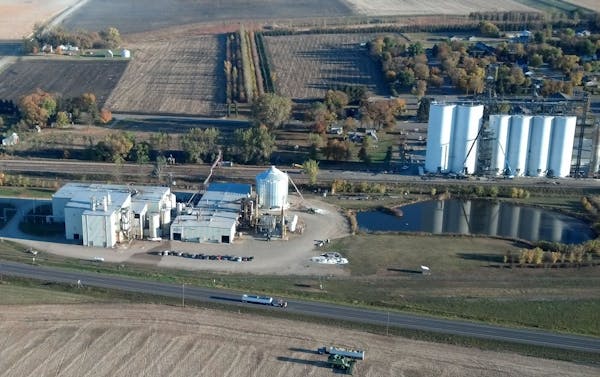The higher-ethanol fuel blend called E15 is hitting the Twin Cities through an unusual marriage between corn growers and independent gas stations.
Penn Mobil in south Minneapolis is the first Minnesota station to offer the 15 percent ethanol fuel, but other stations are planning to sell the new blend, ethanol industry officials said Monday.
Minnesota corn growers, who stand to benefit from increased ethanol sales, are helping to clear a barrier to E15 by subsidizing the expensive upgrades to gas pumps so they can dispense higher-ethanol fuel.
The strategy represents a direct retail confrontation with the oil industry, which has been fighting a high-stakes political war with the ethanol industry over expansion of renewable fuels. With 21 ethanol plants, Minnesota is one of the largest producers of the biofuel.
"It is a major market-share battle," said Mike O'Brien, vice president for business development at Growth Energy, an ethanol industry trade group that has promoted the strategy.
Some independent station owners, led by Penn Mobil's Richard Bohnen, not only are adding E15, but they are cutting ties to major oil companies. At least four stations plan to rebrand under a new oil company, Minnoco, owned and controlled by station owners.
"The advantage is that you own your own brand," said Bohnen, the second-generation owner of the longtime Mobil station at 60th Street and Penn Avenue S. in Minneapolis, and founding president of Minnoco.
Will consumers buy E15?
At the Penn Avenue station, which began selling E15 two weeks ago, another advantage flashed Monday in big numbers on the price sign: E15 was 15 cents a gallon cheaper than E10, the standard 10 percent ethanol blend. Bohnen said typically E15 will be less costly because wholesale ethanol usually carries a lower price than gasoline.
The price was attractive to Heather Olson, who pulled up in her 2012 Honda and selected E15 — but only after Bohnen explained what it was. "I didn't know anything about it," Olson said. "I will watch my gas mileage. Cheaper is always good."
Most U.S. cars and trucks were designed for E10. But the U.S. Environmental Protection Agency, based on testing of new and old vehicles, has approved E15 for 2001 and newer cars, SUVs and light trucks.
Pre-2001 vehicles as well as motorcycles and various other small and large engines are not approved for E15 because of concern about engine damage.
Adding to the potential confusion, the U.S. auto industry doesn't endorse E15. Ford and GM have approved E15, but only for more recent models.
The Alliance of Automobile Manufacturers advises car owners to check their owners' manuals. For cars designed for E10, the use of E15 carries "a strong possibility of corrosion over time," said Gloria Bergquist, a vice president of the group, in an interview Monday.
O'Brien of Growth Energy said that's nonsense. In the past six months, 25 stations in eight states have sold 250,000 gallons of E15 without one complaint, he said.
The American Petroleum Institute, the oil industry trade group, did not return a phone call seeking comment Monday.
Ethanol and the 'blend wall'
The ethanol industry wants to sell higher-ethanol blends so its market doesn't max out at 10 percent of the nation's fuel supply — what the industry calls the "blend wall."
Part of that strategy is to sell fuel blends of up to 85 percent, or E85, to owners of flexible fuel cars. But that market is limited. E15 is aimed at the majority of car owners, 75 percent of whom drive 2001 or newer vehicles.
Yet the pumps to dispense higher-ethanol fuels, called blender or flex pumps, are expensive. A station conversion can cost $100,000 and up, industry officials said.
And most gas stations — even those that carry the name of a major oil company — are independently owned small businesses, said Lance Klatt, executive director of the Minnesota Service Station & Convenience Store Association.
So the Minnesota Corn Growers Association chipped in $2 million and the Minnesota Department of Agriculture another $1 million over two years to offer technology grants to station owners who agree to sell E15. The American Lung Association of Minnesota, a promoter of clean-burning fuels, administers the money, and it has approved the Penn Avenue station among the first five recipients.
"Our hope is that over the next couple of years, we will get 40 or 50 or more," said Tim Gerlach, executive director of the corn growers' association based in Shakopee. There are 2,800 gas stations in Minnesota.
Not all of the E15 sellers are expected to rebrand as Minnoco stations. But stations in Shakopee, Coon Rapids and Maplewood are making the switch, and a station in Willmar is considering it. Bohnen said Minnoco stations won't be required to carry E15, though the first ones are doing so.
Turning away from big oil companies carries a cost. Jerry Charmoli, owner of the Hwy. 10 Mobil in Coon Rapids, said that he's spending $250,000 on the switch to E15 and Minnoco next month and that he hasn't decided yet whether to accept the grant.
With their own brand, stations expect to save money on credit card fees. They won't be restricted to one fuel supplier, but they'll need to do their own brand marketing.
Charmoli, whose contract with Mobil had come up, said he thinks it's worth it. "It's our own brand," he said. "We can control our own destiny."
David Shaffer • 612-673-7090 @ShafferStrib
